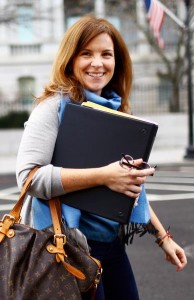In my last post, Those amateurs in Washington, I briefly mentioned the name Alyssa Mastromonaco, whose piece in the Washington Post generated the interest of State Department spokesperson Jen Psaki to the extent that she tweeted a friend about it in the middle of the downed airliner crisis.

Alyssa Mastromonaco is the subject of this exploratory piece on how campaign staffers get positions in the administration. (Marie Claire photo)
“Great piece by former colleague Alyssa Mastromonaco who defines smart, savvy and fashionable,” Psaki tweeted, according to blogger Pat Dollard.
Frankly, my curiosity got the best of me. Over the years I have come to recognize the names of a number of Obama administration staffers, but I had not heard of Mastromonaco.
So, exactly who is Alyssa Mastromonaco, and how did she wind up at a desk just outside the Oval Office?
After growing up in Rhinebeck, NY, she attended the University of Vermont. She did a stint as an intern for Socialist Rep. Bernie Sanders (D-VT) during his campaign for a fourth term. She later transferred to the liberal University of Wisconsin-Madison, where she majored in political science and graduated with a BA in 1998.
She was press secretary for former Rep. Rick Boucher (D-VA) before joining Sen. John Kerry’s 2004 presidential campaign staff as his scheduler with a $19,000 salary. When that ended, Obama confidant Robert Gibbs, later his press secretary, invited her to work for the Obama team; first for then Senator Obama as his director of scheduling before being named political director for Obama’s PAC, Hopefund.
In 2007, she became director of scheduling for Obama’s 2008 campaign and in January 2011 became the president’s director of scheduling, earning $172,000. While responsible for the planning and setup of presidential events, she oversaw presidential personnel, hiring and political appointments in the executive branch and screening cabinet appointments. She coordinated everything between the Secret Service, military personnel controlling Air Force One and Marine Two, the first family, and of course Valarie Jarrett
Later that year, the New Republic featured her in a piece entitled, Washington’s Most Powerful, Least Famous People, as someone who “had a hand in the campaign’s most sensitive decisions.”
In April 2013, ELLE and Gucci included her on ELLE’s Third Annual Power List, a list of ten female power players in Washington DC. “When people need something at the White House, ” she remarked, “I have a lot of swat.”
The New York Times identified her as one of “the most influential people inside the campaign whose names were not on television or in the newspapers, but whose role could well have been vital to the outcome of the race.”
In May 2014, Mastromonaco left the White House for a position as contributing editor with Marie Claire magazine, the same publication that did a piece on her, The White House Gatekeeper, a year earlier. No salary was divulged.
Mastromonaco didn’t waste any time getting involved in a controversy over women’s magazines after Politico declared, “women’s magazines demean powerful women.” You can read her views in her Washington Post opinion piece, July 19, 2014.
Readers of this blog may recall that I wrote about Texas Democrat gubernatorial candidate Wendy Davis, who appeared in a Vogue magazine puff piece and talked about chic clothing in her wardrobe, while claiming she was in touch with the average Texas woman (Who’s out of touch, Wendy?, Jan. 1, 2014).
My original intention in writing this piece, however, was not to disparage women’s magazines. It is an offshoot from my piece, It’s amateur time in Washington, July 21, 2014, designed to show you how this political campaign staffer got her positions in the administration. I believe it’s fairly typical. In fact, replacing Mastromonaco was Anita Decker Breckenridge, who has supported the president since his early days as senator, overseeing his regional offices in downstate Illinois.





